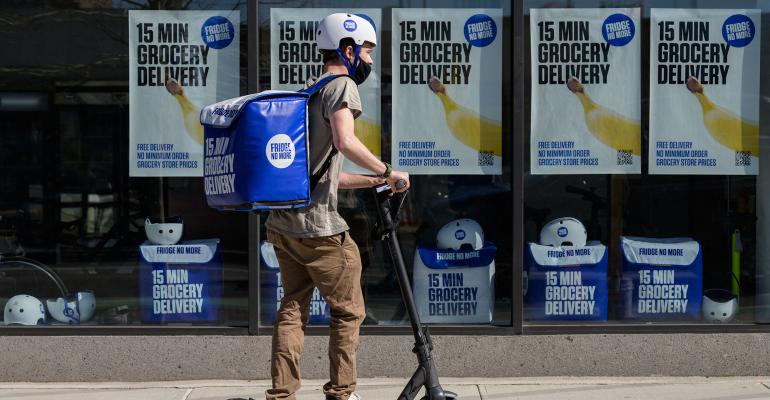The rise of rapid grocery delivery startups is creating demand for a new kind of logistics property.
As the e-commerce boom continues, one of its rapidly growing offshoots appears poised to become a key disruptive trend of 2021. Since early 2020, consumer demand for delivery of basic essentials has triggered major growth for specialized online grocery services, a relatively new subsector that’s already impacting major urban real estate markets.
Startups like JOKR, Gorillas, 1520, Getir, Fridge No More and others are using local mini-fulfillment centers in urban areas to offer ultra-fast delivery, sometimes in as little as 15 minutes, and competing with established e-grocers like Amazon Fresh and Fresh Direct and delivery services like Instacart.
As they enter major markets, these companies are turning to small retail and industrial properties that bring them as close as possible to consumers while keeping rents low. These micro fulfillment centers range from 1,500 to 5,000 sq. ft. and typically serve a delivery radius of one to three miles. The centers are usually “dark stores,” not meant to be open to the public, and though the concept may not be new, these dark stores are now central to the business model of the rapid delivery grocery startup.
“We’re always aiming to secure easily accessible space to be closer to customers and ensure our fastest delivery possible,” says Tyler Trerotola, JOKR’s U.S. co-founder.
Much of the e-commerce growth during the pandemic has been in established industries—the standard fare of UberEats and DoorDash and the deliver-anything services like Roadie or Postmates. But for grocery delivery, the market has expanded dramatically.
In 2020, almost 30 percent of people in the U.S. said they had placed an online order for groceries compared to 4.5 percent in 2019, according to real estate services firm JLL. Around 45 percent of consumers now order online grocery delivery more than they did before COVID-19, according to a new report by Acosta. By the end of 2020, online grocery sales were up 50 percent year-over-year.
“Most grocers agree that online orders with home delivery or customer pick-up at the store are here to stay, and are planning accordingly,” says Rick Weinberg, executive vice president at commercial real estate services firm CBRE. “Statistics back up the assumption, as pre-pandemic online grocery sales were averaging 2 to 3 percent [of total sales], currently averaging 10 to 12 percent, while future projections are as high as 20 percent.”
Statistics from the Food Marketing Institute and Nielsen have led to projections that annual online grocery sales could show $100 billion in growth by 2022, compared to 2018. Startup investors have already recognized this market potential and many of the new grocery delivery services have raised funding in the hundreds of millions.
“The key thing is that these are growth industries: these were not around back in the day, outside of Peapod, which was one of the pioneers in the sector,” says George Cutro, director of industrial research at JLL. “Now you’ve got numerous people jumping on the bandwagon to provide that grocery store-to-home service.”
“We strongly believe that the pandemic has only catalyzed a movement that was bound to happen anyway,” says Trerotola. “People have become more sophisticated and demanding in their expectations of retail in general, and particularly when it comes to their daily essentials.”
New types of logistics
The pre-pandemic e-grocery industry belonged primarily to more traditional players: supermarkets with their own delivery services or e-commerce giants offering groceries in the model of Amazon or Shipt. The past year has also seen new partnerships between leading delivery services and supermarkets, with Instacart adding over 200 new retail partnerships in 2020.
But the rise of e-grocery startups in particular is introducing new demand for a specific kind of logistics property. In some areas, e-grocery startups look for vacated retail spaces, often at reduced rents due to the market disruptions of the pandemic.
“In some secondary and tertiary markets, retail vacancy rents have become lower than industrial, which historically has rarely been the case,” says Weinberg.
This is due, in part, to the supply-demand constraints in the industrial sector—another theme throughout the pandemic—as overall industrial rents increase while supply remains limited.
“When we’re expanding into a new neighborhood, we try to revitalize empty storefronts and partner with local businesses to serve the community with the products they love,” says Trerotola. “We’re always on the hunt for more properties in new neighborhoods, and we have region-specific co-founders in every international market and executives on the ground in every market we operate in, so we’re connected and communicating with the community.”
The rents for these mini fulfillment centers can vary widely by submarket, as well as whether the delivery business needs a cooler/freezer component on-site, according to JLL.
Grocery delivery startups can also make use of relatively low-rent industrial spaces in prime locations. Small industrial properties are an attractive prospect for these startups as they’re focused on population density in their target areas, not on foot traffic. “We’ve seen them taking existing class-C inventory, and they’re really focused on being close to the urban core, where they can deliver to the millennials who are ordering their food products online, especially prepared meals,” notes Chad Buch, research manager at JLL.
At the same time, supermarkets offering grocery deliveries are also seeking properties for local logistics support, but typically try to build on their existing presence in the area in order to meet rising demand. Traditional bricks-and-mortar supermarkets may also need more facilities that allow for dry good storage and refrigeration, as well as longer-term cold storage.
“Most larger national and regional grocers have in-house fulfillment or partner with tech companies to develop proprietary off-site automated or semi- automated fulfillment operations,” says Weinberg. “Online grocery services typically add pressure to individual store stocking fulfillment as those orders are filled and delivered directly from individual stores.”
These fulfillment centers are also much larger than the ones used by the startups, even at the small end, with supermarkets seeking 10,000-sq.-ft. to 50,000-sq.-ft. off-store properties in multi-store markets, according to Weinberg. Walmart, for example, has announced plans to roll out automated mini-warehouses between 20,000 sq. ft. and 30,000 sq. ft. this year to speed up its deliveries.
According to CBRE, demand for new space from the supermarket chains is primarily focused on industrial properties for expanded fulfillment requirements.
For both supermarkets and the new rapid delivery e-grocers, the shift to delivery means location matters much more for these logistics facilities than before.
“Just think about the urban planning of the U.S.: it was retail in the center, surrounded by residential, and they put industrial way out, far away from the retail and the residential. Well, e-commerce has flipped that,” says Kris Bjornson, international director with JLL Industrial. “The e-commerce models that we work on, even from the large fulfillment centers to the last mile facilities, is all about getting to that buyer density… Our clients are looking to solve not just ‘location, location, location,’ it’s ‘logistics, logistics, location.’”
For now, the growth of e-grocery doesn’t appear to be having a major impact on the demand for bricks-and-mortar supermarkets and grocery-anchored shopping centers, at least not yet. Pricing for these assets has remained strong through 2020, falling by only 1.8 percent. And grocery-anchored retail centers under 100,000 sq. ft. are set to be one the most in-demand asset classes over the next 12 to 18 months, according to JLL.
Source: Read Original Article






